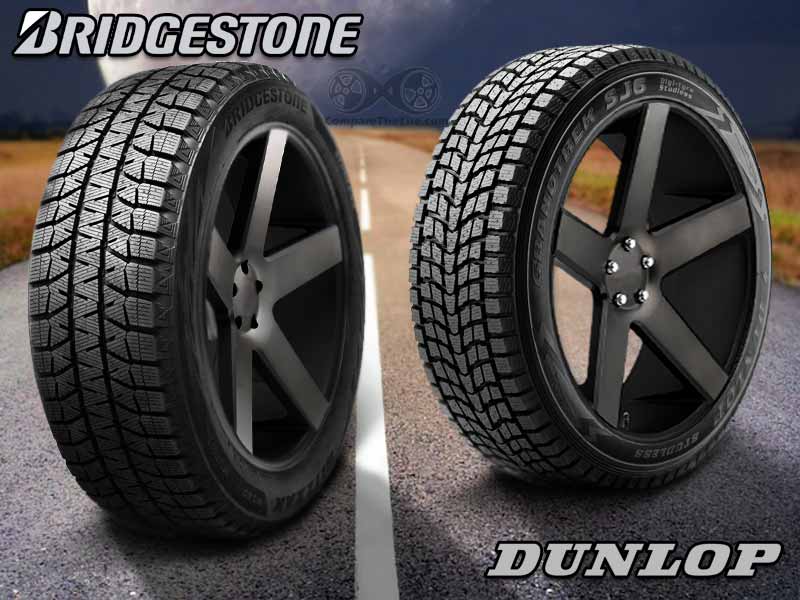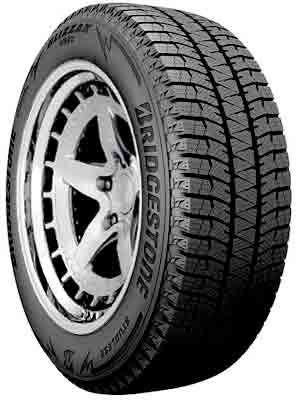Dunlop SJ6 and Blizzak WS90 are architectured to disclose their unparalleled winter performance for the drivers of SUVs & Light Trucks. Both being premium touring studless winter tires, are heavily recommended for demonstrating their power in both on and off-road harsh winter conditions.
SJ6 with its unique zigzag central grooves made it possible to offer best-in-class grip on wet, icy, and snowy roads. Its outstanding road handling facility is provided by the most improved and the latest Silica-Plus compound construction. Because of its systematically optimized tread pattern, it gives superior hydroplaning resistivity. Finally, its reinforced strong threads made up of fiber-glass made it a more durable and comfortable rider in the competition.

The Bridgestone Blizzak WS90 is powered by its Patented Multi-Cell Technology that gives its riders proven confidence over dry and icy paths. It is considered a leader in ice handling facilities solely due to its silica-enhanced compounds in the construction of tires. Its Edge Performance Technology Package brings advanced speeds with near to silent rides.
Compared to WS90, SJ6 is far ahead in many supreme features like fuel efficiency, durability, hydroplaning resistivity, superior grip & handling facility along with providing comfortable rides. Whereas WS90 is ahead in features like superior speeds, less noise production, and dry road grip facilities.
But same was not the case when we compare Blizzak with Michelin’s X Ice tires.
Table of Contents
Side By Side Comparison
Dunlop Grandtrek SJ6

Bridgestone Blizzak Ws90

| Specifications | Dunlop SJ6 | Blizzak WS90 |
| Tire Type | Premium Touring Tire | Premium Touring Tire |
| Tire Season | Winter | Winter |
| Tread Pattern | Directional | Directional |
| Available Sizes, Inches | 15, 16, 17, 18 | 14, 15, 16, 17, 18, 19 |
| Application | SUVs & 4×4s | SUVs & 4×4s |
| Standard limited warranty | 6 Years | 5 Years |
| Cost (215/70R15) | $15.90 (old price since it is out of stock) | $135.51 |
Tread Design
SJ6 is structured in a directional tread pattern. It has six circumferential grooves of different widths. Which makes an inconsistent contact patch. But as compared to its adversary’s, its contact patch is lesser. And unlike its adversary, it has five tread block columns. There are high-density zigzag sipes all over the length of the tire. And it doesn’t have any notches on the entire length of the tire. Its shoulder blocks are comparatively larger than its adversary’s shoulder blocks.
Bridgestone WS90 is also structured in a directional tread pattern but with four circumferential grooves of different widths. Which also makes an inconsistent contact patch. But its overall contact patch is more than its adversary’s. It has two tread block columns and one central rib with the shape of a continuous ‘S’. Plus, it has notches on the central rib and two adjacent tread block columns. And like its adversary, it has zigzag-shaped sipes all over the length of the tire but they are comparatively of low density when compared with its adversary. Its shoulder blocks are also relatively smaller.
Grip Comparison
SJ6 would provide an inferior grip for dry roads as its contact patch is comparatively lesser than its adversary. But it would provide a better grip on wet and icy roads as its sipes are of comparatively higher density which would offer high biting edges on slippery wet and icy pavements. It would perform comparatively better in snow traction because overall its void ratio is higher than its adversary
WS90 would provide superior grip on dry pavements thanks to its comparatively more contact patch than its adversary. But its grip facility on wet and icy pavements would be quite decent but can’t compete with its rival’s ability in this case. It also lacks in the competition of snow grip since its void ratio is relatively lower than its adversary.
| Parameters | Dunlop SJ6 | Blizzak WS90 |
| Dry Grip | Moderate | High |
| Wet Grip | High | Moderate |
| Ice Grip | High | Moderate |
| Snow Grip | High | Moderate |
Handling Comparison
SJ6’s dry road handling facility would be greater due to its comparatively larger shoulder blocks than its adversary. Having a siping pattern of relatively high density on its shoulders, SJ6’s handling ability on wet and icy roads would be comparatively greater since it would provide better biting edges during steering operation. Finally, its snow handling facility would be more reliable than its adversary’s thanks to its wider lateral grooves with biting edges on its shoulders.
WS90’s dry road handling facility would be inferior to its adversary’s due to its comparatively smaller shoulder blocks. Similarly, its wet and ice road-handling facility would also be inferior to its adversary’s due to comparatively low-density sipes on its shoulder blocks. Finally, its snow handling facility would also be less reliable than its adversary’s because its lateral grooves on shoulder blocks are relatively narrower than those of its adversary.
| Parameters | Dunlop SJ6 | Blizzak WS90 |
| Dry Handling | High | Low |
| Wet Handling | High | Moderate |
| Ice Handling | High | Moderate |
| Snow Handling | High | Moderate |
Hydroplaning Resistivity
SJ6’s hydroplaning resistivity would be superior to its adversary’s because it has comparatively wider circumferential and lateral grooves which makes a relatively high void ratio than its rival.
Durability
Let’s have a look at the data table defining the tread depths of both contenders for a better understanding of the durability factor in the competition.
| Contenders | Tread Depth |
| Dunlop SJ6 | 14/32″ |
| Blizzak WS90 | 12/32″ |
After having a glance over the data table, we can conclude that SJ6 would be more durable than its adversary because it would take relatively more miles to wear out.
Comfort and Noise
Tread depth also determines the extent of comfortable rides. Because it’s the tread depth that initially absorbs shocks of bumpy roads and provides a cushion between the vehicle and the road for a smooth journey. So SJ6 would win in the race of providing more comfortable rides.
When vehicles drive at maximum speeds, air particles get captured in between the tread blocks of the tires. So resultantly noise would be produced when air particles would collide with the walls of tread blocks. So WS90 would win the race in the competition of producing less noise because it has a comparatively less void ratio than its adversary.
So SJ6 would provide more comfortable rides but WS90 would produce comparatively less noise.
Rolling Resistance and Fuel Efficiency
SJ6 would be more fuel-efficient because it has less contact patch than its adversary’s. Less contact patch leads to less rolling resistance. Rolling resistance relates to the friction force between tires and roads that resist tires from moving. And finally, less rolling resistance translates into less fuel consumption. So SJ6 is a winner in the competition of the fuel-efficiency sector because it has less contact patch that leads to less rolling resistance.
Load and Speed
Looking at the table that relates to the load and speed data of both contenders would be a better source for analysis.
| Contenders | Speed Rating | Max Speed (mph) | Load Index | Max Load (lbs.) |
| Dunlop SJ6 | Q | 100 | 98 | 1653 |
| Blizzak WS90 | T | 118 | 98 | 1653 |
So as we can see that both contenders are tied in the load-bearing capabilities but WS90 wins the race in the speed competition.
Quick Summary
Both Contenders;
- are premium winter touring tires with directional tread patterns best suited for SUVs and 4×4s.
- can carry equal weights.
Dunlop SJ6;
- provides superior wet and snow traction.
- provides superior road handling facility.
- provides more comfortable rides with better hydroplaning resistivity, extended durability, and long-lasting fuel efficiency.
Blizzak WS90;
- provides better dry road and ice tractions.
- produces less noise.


